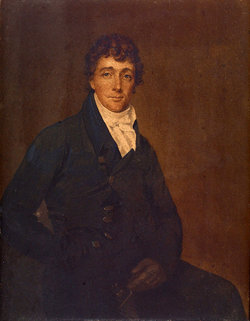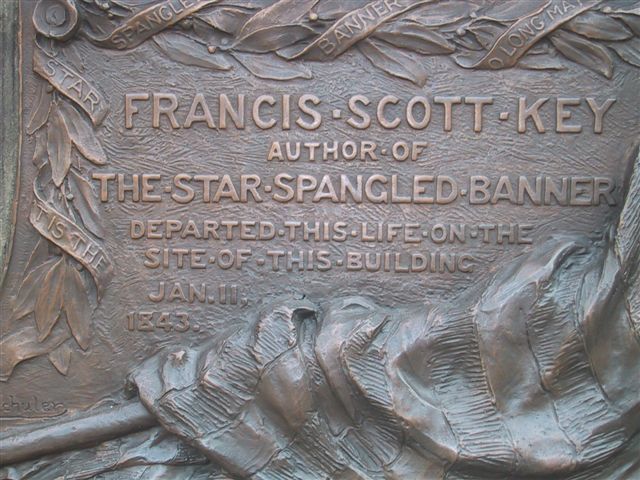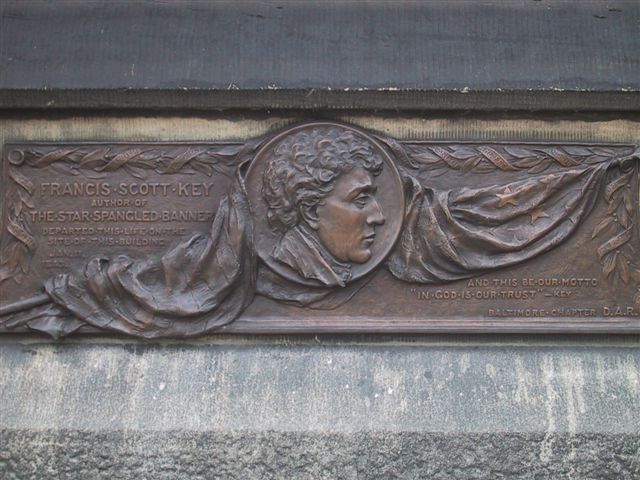Born at Terra Rubra, his family's 1,865-acre plantation in Frederick County north of Keymar, which today is in Carroll County, Maryland, he was the son of Judge John Ross Key and his wife Anne Phebe Penn Dagworthy Charlton. He went to St. John's School in Annapolis and then continued to study law with his uncle's firm, passing the bar in 1801. He considered the ministry more than once in his life and became a leader in the Sunday School movement. His published works include "The Power of Literature and Its Connection with Religion" in 1834 and the posthumous collection "Poems" in 1857.
By 1805, he had his own well-established law practice in Georgetown, a few miles from the nation's capital. The tranquility usually found here had been broken by the British attack during the War of 1812 and the capture of Washington, D.C. The British had set fire to both the Capitol and the White House on August 24, 1814, the flames of which could be seen 40 miles away in Baltimore.
Learning that a much-respected elderly physician, Dr. William Beanes, was hostage on the British flagship "Tonnant," Key together with Colonel John Skinner, an American agent for prisoner exchange, set sail on a sloop from Baltimore flying a flag of truce. This potentially-dangerous mission was with the approval of United States President James Madison. After much negotiation with the British, the release was arranged, but, since they had overheard the preparations for the attack on Baltimore, they were forced to wait under guard behind the British fleet. It was from this position that, after a long night of battle, they were assured that, despite the 25-hour shelling, Fort McHenry had not surrendered. Long before dawn, there was a sudden and mysterious silence and waiting in the darkness. The anxiety was finally broken when daylight came as the flag was still there! On September 14, 1814, this led the amateur poet to write on the back of a letter in his pocket the lines that would become the Unites States National Anthem.
Later that same month the "Baltimore Patriot" published the completed verses under the title "Defence of Fort M'Henry" with the added note "Tune: Anacreon in Heaven." A Baltimore actor sang the new song in a public performance the next month as "The Star-Spangled Banner," and it became a popular patriotic song. In 1931, the United States Congress enacted legislation that made this the official National Anthem.
Key was appointed the United States District Attorney for Washington, D.C., appearing many times before the Supreme Court. Married in 1802 to Mary Tayloe Lloyd, the couple had six sons and five daughters and continued to live in Georgetown until around 1833.
He died in Baltimore from pleurisy while visiting his daughter Elizabeth Howard and was first buried at Saint Paul's Cemetery there, but was removed to his family's lot in Frederick in 1866. The Key Monument Association erected a memorial in 1898 and the remains of both Francis Scott Key and his wife were placed in a crypt in the base of the monument. There are cenotaphs at Fort McHenry, on Eutaw Street in Baltimore, and at the Presidio in San Francisco, California. His collateral relative, F. Scott Fitzgerald, novelist, was named for him.
Born at Terra Rubra, his family's 1,865-acre plantation in Frederick County north of Keymar, which today is in Carroll County, Maryland, he was the son of Judge John Ross Key and his wife Anne Phebe Penn Dagworthy Charlton. He went to St. John's School in Annapolis and then continued to study law with his uncle's firm, passing the bar in 1801. He considered the ministry more than once in his life and became a leader in the Sunday School movement. His published works include "The Power of Literature and Its Connection with Religion" in 1834 and the posthumous collection "Poems" in 1857.
By 1805, he had his own well-established law practice in Georgetown, a few miles from the nation's capital. The tranquility usually found here had been broken by the British attack during the War of 1812 and the capture of Washington, D.C. The British had set fire to both the Capitol and the White House on August 24, 1814, the flames of which could be seen 40 miles away in Baltimore.
Learning that a much-respected elderly physician, Dr. William Beanes, was hostage on the British flagship "Tonnant," Key together with Colonel John Skinner, an American agent for prisoner exchange, set sail on a sloop from Baltimore flying a flag of truce. This potentially-dangerous mission was with the approval of United States President James Madison. After much negotiation with the British, the release was arranged, but, since they had overheard the preparations for the attack on Baltimore, they were forced to wait under guard behind the British fleet. It was from this position that, after a long night of battle, they were assured that, despite the 25-hour shelling, Fort McHenry had not surrendered. Long before dawn, there was a sudden and mysterious silence and waiting in the darkness. The anxiety was finally broken when daylight came as the flag was still there! On September 14, 1814, this led the amateur poet to write on the back of a letter in his pocket the lines that would become the Unites States National Anthem.
Later that same month the "Baltimore Patriot" published the completed verses under the title "Defence of Fort M'Henry" with the added note "Tune: Anacreon in Heaven." A Baltimore actor sang the new song in a public performance the next month as "The Star-Spangled Banner," and it became a popular patriotic song. In 1931, the United States Congress enacted legislation that made this the official National Anthem.
Key was appointed the United States District Attorney for Washington, D.C., appearing many times before the Supreme Court. Married in 1802 to Mary Tayloe Lloyd, the couple had six sons and five daughters and continued to live in Georgetown until around 1833.
He died in Baltimore from pleurisy while visiting his daughter Elizabeth Howard and was first buried at Saint Paul's Cemetery there, but was removed to his family's lot in Frederick in 1866. The Key Monument Association erected a memorial in 1898 and the remains of both Francis Scott Key and his wife were placed in a crypt in the base of the monument. There are cenotaphs at Fort McHenry, on Eutaw Street in Baltimore, and at the Presidio in San Francisco, California. His collateral relative, F. Scott Fitzgerald, novelist, was named for him.
Bio by: D C McJonathan-Swarm
Inscription
"Author of the Star Spangled Banner"
Family Members
Advertisement
See more Key memorials in:
Explore more
Sponsored by Ancestry
Advertisement









